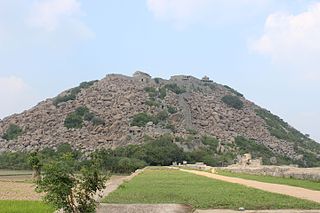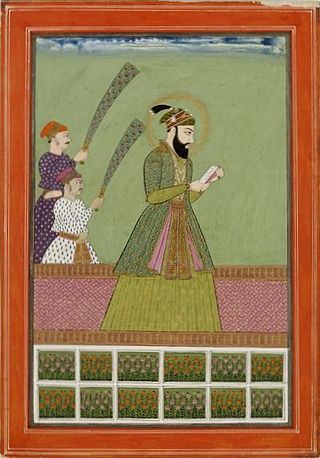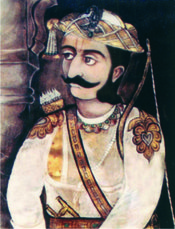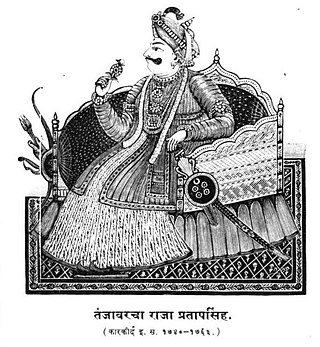Nawab is a royal title indicating a ruler, often of a South Asian state, in many ways comparable to the western title of Prince. The relationship of a Nawab to the Emperor of India has been compared to that of the Kings of Saxony to the German Emperor. In earlier times the title was ratified and bestowed by the reigning Mughal emperor to semi-autonomous Muslim rulers of subdivisions or princely states in the Indian subcontinent loyal to the Mughal Empire, for example the Nawabs of Bengal.

Mirza Nasir-ud-Din Muḥammad Shah was the thirteenth Mughal emperor from 1719 to 1748. He was son of Khujista Akhtar, the fourth son of Bahadur Shah I. After being chosen by the Sayyid Brothers of Barha, he ascended the throne at the young age of 16, under their strict supervision.

The First Anglo-Mysore War (1767–1769) was a conflict in India between the Sultanate of Mysore and the East India Company. The war was instigated in part by the machinations of Asaf Jah II, the Nizam of Hyderabad, who sought to divert the company's resources from attempts to gain control over the Northern Circars.

Ahmad Shah Bahadur, also known as Mirza Ahmad Shah or Mujahid-ud-Din Ahmad Shah Ghazi, was the fourteenth Mughal emperor, born to Emperor Muhammad Shah. He succeeded his father to the throne in 1748, at the age of 22. When Ahmed Shah Bahadur came to power, the Mughal Empire started to decline. Furthermore, his administrative weakness eventually led to the rise of the usurping Imad-ul-Mulk.

The Carnatic wars were a series of military conflicts in the middle of the 18th century in India's coastal Carnatic region, a dependency of Hyderabad State, India. The first Carnatic wars were fought between 1740 and 1748.

Gingee, also known as Senji or Jinji and originally called Singapuri, is a panchayat town in Viluppuram district in the Indian state of Tamil Nadu. Gingee is located between three hills covering a perimeter of 3 km, and lies west of the Sankaraparani River.

Mir Ahmad Ali Khan Siddiqi Bayafandi, Nasir Jung, was the second Nizam of Hyderabad State. He was the son of Asaf Jah I and his wife Saeed-un-nisa Begum. He was born 26 February 1712. He had taken up a title of Humayun Jah, Nizam ud-Daula, Nawab Mir Ahmad Ali Khan Siddiqi Bahadur, Nasir Jung, Nawab Subadar of the Deccan. However, he is most famously known as Nasir Jung.

Muhammad Ali Khan Wallajah, or Muhammed Ali, Wallajah, was the Nawab of the Carnatic from 1749 until his death in 1795. He declared himself Nawab in 1749. This position was disputed between Wallajah and Chanda Sahib. In 1752, after several clashes, Chanda Sahib's forces and his French allies were expelled from Arcot, officially declaring Wallajah as Nawab on 26 August 1765. His reign was recognised by Mughal emperor Shah Alam II.

Chanda Sahib was a subject of the Carnatic Sultanate between 1749 and 1752. He was the son-in-law of the Nawab of Carnatic Dost Ali Khan, under whom he was a Dewan. An ally of the French, he was initially supported by Joseph François Dupleix during the Carnatic Wars. He annexed the Madurai Nayaks and was declared Nawab, bringing Tanjore and Tinnevelly into the dominions of the Mughal Empire.

Sa'adatullah Khan I or Sa'adatullah Khan was Nawab of Carnatic (r.1710–1732). He was an adventurer from Konkan in Maharashtra.
Ali Dost Khan, often referred to as Dost Ali Khan, was the Nawab of the Carnatic from 1732 to 1740. He was the son of Ghulam Ali Khan, brother of the Nawab Saadatullah Khan. His childless uncle adopted him as heir, and he succeeded his uncle in 1732, he successfully gained the investiture and an official Firman by the Mughal Emperor Muhammad Shah.
Sa'adatullah Khan II a.k.a. Muhammad Sayyid was Nawab of Arcot, who was a younger son of Safdar Ali Khan.

Raghuji I was a Maratha general of the Bhonsle clan who established the Nagpur Kingdom in much of east-central India during the reign of Chhatrapati Shahu I. His successors ruled the kingdom until 1853.

Pratap Singh Bhonsle or Pratapsinha was the Maratha ruler of Thanjavur of the Bhonsle dynasty from 1739 to 1763. His rise to power followed three years of anarchy and civil war and restored the state to its previous greatness. His reign witnessed the Carnatic Wars and the Seven Years' War.

Ghulam Muhammad Ghouse Khan was the 12th and last Nawab of the Carnatic. He reigned from 1825 to 1855. He belonged to the Second Dynasty.

The siege of Arcot took place at Arcot, India between forces of the British East India Company led by Robert Clive allied with Muhammad Ali Khan Wallajah and forces of Nawab of the Carnatic, Chanda Sahib, allied with the French East India Company. It was part of the Second Carnatic War.

The siege of Trichinopoly was part of an extended series of conflicts between the Nizam of Hyderabad and the Maratha Empire for control of the Carnatic region. On 29 August 1743, after a six-month siege, Murari Rao surrendered, giving Nizam ul Mulk (Nizam) the suzerainty of Trichinopoly. By the end of 1743, the Nizam had regained full control of Deccan. This stopped the Maratha interference in the region and ended their hegemony over the Carnatic. The Nizam resolved the internal conflicts among the regional hereditary nobles (Nawabs) for the seat of governor (Subedar) of Arcot State, and monitored the activities of the British East India company and French East India Company by limiting their access to ports and trading.

The siege of Trichinopoly (1751–1752) was conducted by Chanda Sahib, who had been recognized as the Nawab of the Carnatic by representatives of the French East India Company, against the fortress town of Tiruchirappalli, held by Muhammed Ali Khan Wallajah.

Tiruchirappalli is believed to be of great antiquity and has been ruled by the Early Cholas, Mutharaiyars Early Pandyas, Pallavas, Medieval Cholas, Later Cholas, Later Pandyas, Delhi Sultanate, Ma'bar Sultanate, Vijayanagar Empire, Nayak Dynasty, the Carnatic state and the British at different times. The archaeologically important town of Uraiyur which served as the capital of the Early Cholas is a Neighborhood of Tiruchirapalli.

The Battle of Ambur was the first major battle of the Second Carnatic War.


























